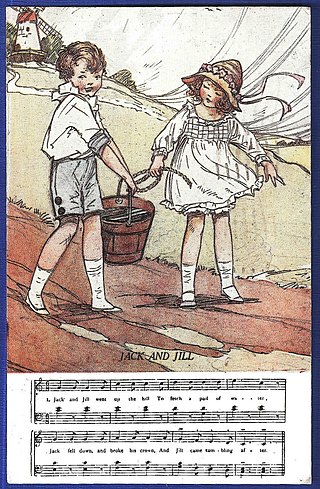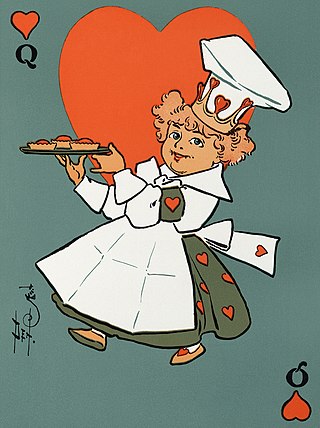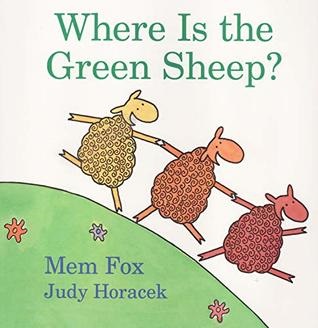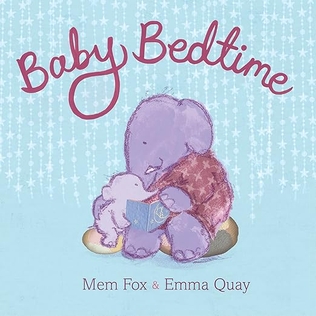
A nursery rhyme is a traditional poem or song for children in Britain and other European countries, but usage of the term dates only from the late 18th/early 19th century. The term Mother Goose rhymes is interchangeable with nursery rhymes.

Humpty Dumpty is a character in an English nursery rhyme, probably originally a riddle and one of the best known in the English-speaking world. He is typically portrayed as an anthropomorphic egg, though he is not explicitly described as such. The first recorded versions of the rhyme date from late eighteenth-century England and the tune from 1870 in James William Elliott's National Nursery Rhymes and Nursery Songs. Its origins are obscure, and several theories have been advanced to suggest original meanings.

Mother Goose is a character that originated in children's fiction, as the imaginary author of a collection of French fairy tales and later of English nursery rhymes. She also appeared in a song, the first stanza of which often functions now as a nursery rhyme. The character also appears in a pantomime tracing its roots to 1806.

"Oranges and Lemons" is a traditional English nursery rhyme, folksong, and singing game which refers to the bells of several churches, all within or close to the City of London. It is listed in the Roud Folk Song Index as No 13190. The earliest known printed version appeared c. 1744.

"Jack and Jill" is a traditional English nursery rhyme. The Roud Folk Song Index classifies the commonest tune and its variations as number 10266, although it has been set to several others. The original rhyme dates back to the 18th century and different numbers of verses were later added, each with variations in the wording. Throughout the 19th century new versions of the story were written featuring different incidents. A number of theories continue to be advanced to explain the rhyme's historical origin.

"Old Mother Hubbard" is an English-language nursery rhyme, first given an extended printing in 1805, although the exact origin of the rhyme is disputed. It has a Roud Folk Song Index number of 19334. After a notable nursery success, it was eventually adapted to a large variety of practical and entertaining uses.

"Little Jack Horner" is a popular English nursery rhyme with the Roud Folk Song Index number 13027. First mentioned in the 18th century, it was early associated with acts of opportunism, particularly in politics. Moralists also rewrote and expanded the poem so as to counter its celebration of greediness. The name of Jack Horner also came to be applied to a completely different and older poem on a folkloric theme; and in the 19th century, it was claimed that the rhyme was originally composed in satirical reference to the dishonest actions of Thomas Horner in the Tudor period.

"Ring a Ring o' Roses", "Ring a Ring o' Rosie", or "Ring Around the Rosie", is a nursery rhyme, folk song and playground singing game. Descriptions first emerge in the mid-19th century, but are reported as dating from decades before, and similar rhymes are known from across Europe, with various lyrics. It has a Roud Folk Song Index number of 7925.
A children's song may be a nursery rhyme set to music, a song that children invent and share among themselves or a modern creation intended for entertainment, use in the home or education. Although children's songs have been recorded and studied in some cultures more than others, they appear to be universal in human society.

"Pease Porridge Hot" or "Pease Pudding Hot" is an English children's singing game and nursery rhyme. It has a Roud Folk Song Index number of 19631.
Iona Margaret Balfour Opie, and Peter Mason Opie were an English married team of folklorists who applied modern techniques to understanding children's literature and play, in studies such as The Oxford Dictionary of Nursery Rhymes (1951) and The Lore and Language of Schoolchildren (1959). They were also noted anthologists, assembled large collections of children's literature, toys, and games and were regarded as world-famous authorities on children's lore and customs.

Childlore is the folklore or folk culture of children and young people. It includes, for example, rhymes and games played in the school playground. The best known researchers of the field were Iona and Peter Opie.

"The Queen of Hearts" is an English poem and nursery rhyme based on the characters found on playing cards, by an anonymous author, originally published with three lesser-known stanzas, "The King of Spades", "The King of Clubs", and "The Diamond King", in the British publication The European Magazine, vol. 1, no. 4, in April 1782. However, Iona and Peter Opie have argued that there is evidence to suggest that these other stanzas were later additions to an older poem.

Gammer Gurton's Garland: or, The Nursery Parnassus, edited by the literary antiquary Joseph Ritson, is one of the earliest collections of English nursery rhymes. It was first published as a chapbook in 1784, but was three times reprinted in expanded editions during the following century, as were several unrelated children's books with similar titles. Gammer Gurton's Garland put into print for the first time some of our best-known nursery rhymes.

Mother Goose's Little Treasures is a 2007 children's picture book by Iona Opie. It is a collection of nursery rhymes, some little known, chosen by Opie from the Mother Goose oeuvre.

My Very First Mother Goose is a 1996 children's picture book by Iona Opie. It is a collection of sixty-eight nursery rhymes, chosen by Opie from the Mother Goose oeuvre, and illustrated by Rosemary Wells.

Where is the Green Sheep? is a children's picture book written by Mem Fox and illustrated by Judy Horacek. Published by Penguin Books, it depicts various coloured sheep in various activities, with the protagonist, the green sheep, not being seen until the final pages.

5 Little Ducks is a 2016 children's picture book by Caldecott Honor recipient Denise Fleming based on the nursery rhyme of the same name.
Keiko Kasza is a Japanese American picture book author and illustrator. Her works have been translated into multiple languages and feature animals as main characters.

Baby Bedtime is a 2013 children's picture book by Mem Fox and illustrated by Emma Quay. The book, published in America by Beach Lane Books, and published in Australia by Penguin Books Australia, is about an adult elephant getting her baby ready for bed.

















